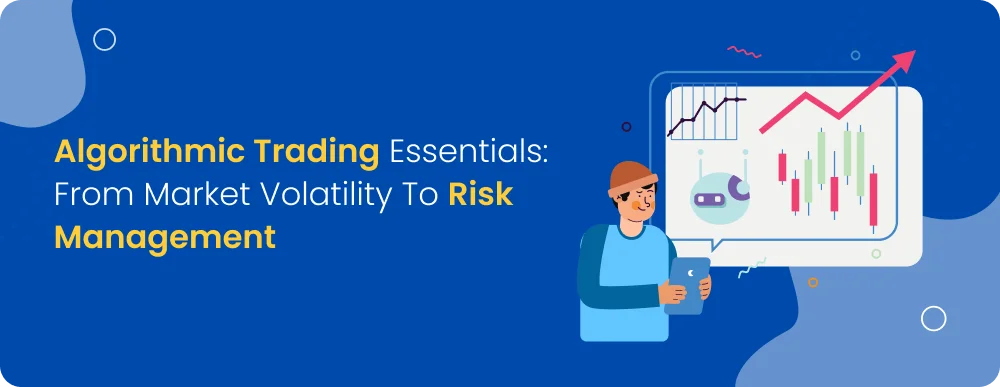Algorithmic Trading Essentials: From Market Volatility To Risk Management
Noor Kaur
30 Oct 2025Tags:
Investing
key Takeaways
- Algorithmic trading replaces emotion with logic; success depends on mastering volatility, latency, and risk management.
- Volatility creates both opportunity and risk; adaptive strategies and solid controls are essential for stability.
- Low latency is critical; even milliseconds of delay can erode profits in high-frequency or arbitrage systems.
- Overfitting, ignoring latency, and weak risk controls are the biggest pitfalls for algo traders.
- Sustainable trading requires robust strategy design, disciplined risk management, continuous adaptation, and diversified systems.
Algorithmic trading has changed how markets move and how traders think. Instead of emotion, it runs on logic. It relies on speed, precision, and rules that execute automatically, instead of instinct.
But behind every profitable algorithm lies an understanding of volatility, latency, and risk. Knowing how these elements interact is what separates consistent systems from fragile ones.
In this blog, we’ll break down how market volatility affects performance, why low latency matters for execution, and how effective risk management keeps algorithms sustainable in the long run.
Understanding Algorithmic Trading in Today’s Markets
Algorithmic trading uses computer programs to execute trades automatically based on predefined rules or models. These systems remove emotional bias and make data-backed decisions at high speed.
From quantitative algorithmic trading models to high-frequency trading algorithms, the goal is to assess market opportunities, execute efficiently, and manage risk effectively.
Suggested Read: Algorithmic Trading Vs High-Frequency Trading
How Market Volatility Influences Trading Performance
For high-frequency trading algorithms, volatility often creates profitable opportunities through fast price changes. But it also increases the risk of execution—you need faster algorithmic trading infrastructure and precise algo backtesting to manage extreme fluctuations.
In contrast, low-frequency trading strategies tend to smooth out short-term volatility, focusing on long-term patterns and minimising exposure to sudden swings. Effective risk controls and adaptive logic are key to navigating volatility successfully.
What is Latency in Trading? Types of Latency Explained
Latency in trading is the time delay between order placement and execution, an important factor in high-frequency and quantitative algorithmic trading.
There are several types:
- Network Latency: Delay in transmitting data between systems.
- Exchange Latency: Time taken by the exchange to process orders.
- Broker Latency: Delay within a broker’s system before execution.
- Software Latency: Lag within the trading algorithm itself.
Why Low Latency Is Critical For High-Frequency And Arbitrage Strategies
Even the most sophisticated algorithmic trading strategies can fail due to human and technical errors. Some of the most common pitfalls include:
- Overfitting during backtesting: Fine-tuning an algorithm too much on historical data can make it unreliable in live markets.
- Poor execution logic: Failing to account for slippage, transaction costs, or market depth can negatively affect real returns.
- Ignoring latency problems: High latency trading causes missed entries and exits, wiping out profits.
- Weak risk controls: Lack of proper algorithmic trading risk management can lead to uncontrolled drawdowns.
Common Pitfalls to Avoid in Algorithmic Trading
Even the most sophisticated algorithmic trading strategies can fail because of human and technical errors. Some of the most common pitfalls are:
- Overfitting during backtesting: Fine-tuning an algorithm too much on historical data can make it unreliable in live markets.
- Ignoring latency issues: High latency trading can cause missed entries and exits and wipe out profits.
- Weak risk controls: Lack of proper algo trading risk management can lead to uncontrolled drawdowns.
- Poor execution logic: Failing to account for slippage, transaction costs, or market depth affects real returns.
Risk Management in Algorithmic Trading: The Core of Success
No matter how advanced your quantitative algorithmic trading model is, it’s only as strong as its risk management. Core elements of algo trading risk management include:
- Position sizing to limit exposure per trade.
- Dynamic stop-loss systems as per volatility.
- Capital allocation rules to diversify risk.
- Real-time monitoring tools to detect anomalies.
Risk controls protect traders from unpredictable markets, system failures, or instant price shocks, in both low-frequency and high-frequency trading.
Best Practices for Sustainable Algorithmic Trading
Here are the best practices that make your quantitative algorithmic trading framework both profitable and resilient:
1. Prioritise Robust Strategy Design
Start with a solid foundation. Base your algorithmic trading strategies on clear logic and market behaviour and not random signals or overfitted models. Each rule should have an economic rationale. Sustainable systems rely on simplicity and repeatability and not luck.
2. Conduct Rigorous Backtesting and Forward Testing
Use detailed algorithmic trading backtesting to test strategies across multiple market cycles. But don’t stop there; follow up with forward testing (paper trading) to validate performance in real-time environments.
3. Build Resilient Infrastructure
A sustainable system needs a strong algorithmic trading infrastructure: reliable servers, secure APIs, and redundancy to prevent downtime. For high-frequency trading algorithms, co-location and direct market access (DMA) are essential to minimise high latency trading and execution errors.
4. Implement Rigorous Risk Management
The core of longevity lies in algo trading risk management. Set strict drawdown limits, use dynamic position sizing, and monitor leverage closely. Risk should be systematically controlled, and not manually adjusted under pressure.
5. Monitor and Adapt Continuously
Markets evolve and so should your algorithms. Regularly analyse performance metrics, adjust parameters and upgrade execution logic. Sustainable traders treat every strategy as a living system that requires fine-tuning, and not a “set and forget” model.
6. Diversify Strategies and Timeframes
Avoid relying on a single quantitative algorithmic trading model. Mix low-frequency trading systems (trend-following or swing) with high-frequency strategies (scalping or arbitrage) to reduce overall volatility and create smoother returns.
Conclusion
Algorithmic trading isn’t just about faster execution, but about smarter control. When traders balance speed with discipline and risk with reward, algorithms stop being tools and start becoming a strategy. The best algo trading systems protect consistency—trade after trade and market after market.
FAQs
Do market regulations influence algorithmic trading strategies?
Yes, market regulations play a crucial role in shaping how algorithmic trading strategies are designed and executed. Exchanges and regulatory bodies like SEBI (in India) and SEC (in the US) enforce rules around order-to-trade ratios, latency controls, and risk checks to stop market manipulation and maintain fairness.
How does slippage affect algorithmic trading performance?
Slippage occurs when the executed price differs from the expected price, often due to high-latency trading or low liquidity. In high-frequency trading algorithms, even milliseconds of delay can lead to significant performance drops. Efficient low-latency systems, smart order routing, and optimised execution algorithms lower slippage and maintain profitability.
Is backtesting enough to build a reliable algorithmic trading strategy?
Algorithmic trading backtesting is essential but not sufficient. While backtesting evaluates a strategy’s performance on historical data, live market conditions, latency, and execution speed can drastically impact real-time outcomes.
What tools are used for risk management in algo trading?
Effective algo trading risk management rely on tools such as:
- Stop-loss and take-profit algorithms for automated exits.
- Position sizing models based on volatility or capital limits.
- Real-time monitoring dashboards for exposure tracking.
- Circuit breakers and kill switches to halt trading during anomalies.
How important is risk management in algorithmic trading?
It’s absolutely critical. Quantitative algorithmic trading systems operate on precision, but markets can move unpredictably. Without strong risk management, even a high-performing strategy can fail during volatility spikes or infrastructure errors.
What common mistakes should beginners avoid in algorithmic trading?
Some of the most frequent mistakes include:
- Over-optimising strategies during backtesting (curve fitting).
- Ignoring latency and real-time execution speed.
- Skipping risk controls or using excessive leverage.
- Deploying strategies without real-market paper testing.
- Relying solely on technical indicators without understanding market structure.
Noor Kaur
30 Oct 2025Related blogs


Intraday Trading Strategy: Open High Open Low Approach
Intraday trading is one of the most exciting and rewarding types of online stock trading. As a day trader, you sho...


Understanding NISM Certification : Everything You Need to Know | mastertrust
In today's world, more and more people are getting curious about finance and the world of money. It doesn't matter...


Seeking Better Returns Than FDs? Explore These Options | mastertrust
Fixed deposits are a popular investment choice because of their guaranteed returns and safety.


Role of Inflation in Long-Term Investment Planning
In Financial Planning, one of the things that plays a key role is the impact of inflation on your investments.
Sign up to our newsletter !
Share this article on
Recent articles
Tags:
Open a Demat Account in just 15 minutes !

Click on open
account below

Fill out some
basic details

Upload your
documents

Start trading in
24 Hours *
Commonly asked questions
Is Master Capital Services Limited SEBI registered?
Do you have a mobile app for Trading and Finance Management?
What services does mastertrust provide?
What is the minimum investment required to start trading with your company?
Is my personal and financial information secure with your company?
What is your customer support availability?





